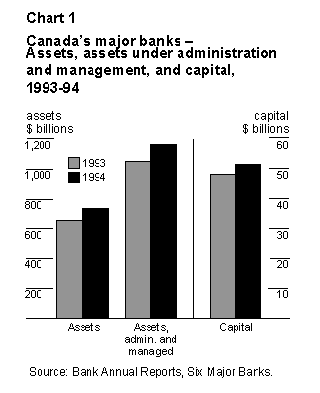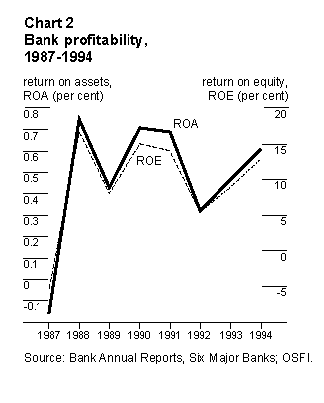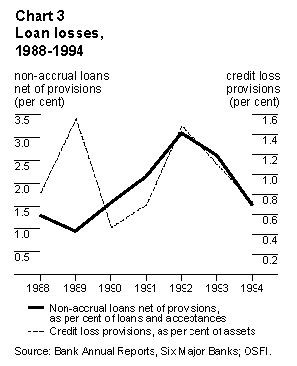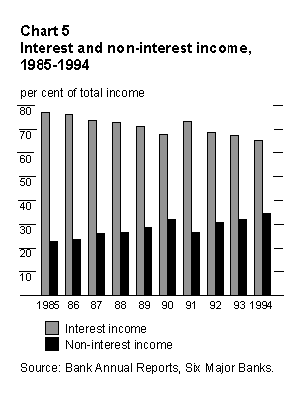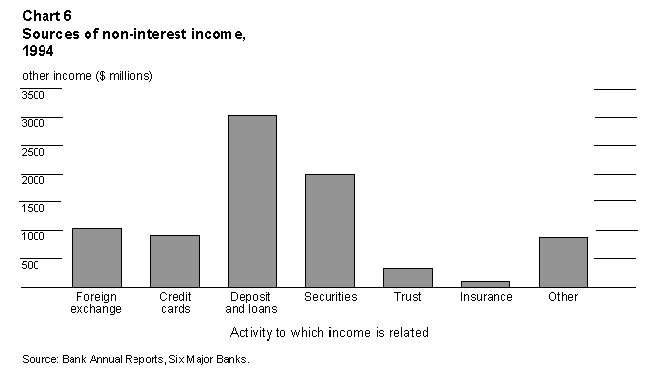|
|
The Canadian Financial System
Canada's Chartered Banks
Key Points
- Canada has nine domestic banks, 50 active foreign bank subsidiaries and 37 foreign bank representative offices.
- Canada's major banks (the so-called "Big Six") are the core of Canada's banking system. With about 90 per cent of bank assets, they provide a wide and expanding spectrum of financial services throughout Canada.
- The major banks have significant international operations in the United States and most other parts of the world.
- Canada's banks are well-capitalized, exceeding Bank for International Settlements' norms by significant margins. The definition of bank capital in Canada is conservative by international standards.
- The major banks have highly developed branch networks (approximately 8,000 branches) and automated banking machine (ABM) networks (more than 12,500 ABMs). Personal deposits, a relatively stable source of funds, account for twothirds of bank deposits.
- There has been some rationalization of the branch structure and employment levels, partly in response to technological change. Canada's banking system is considered highly efficient.
- In the face of growing competition in the traditional banking fields of lending and deposittaking, noninterest income has become an increasingly important source of bank revenues.
- Bank profitability has improved as the Canadian economy has recovered and loan losses have fallen, although many of the smaller foreign bank subsidiaries have not participated fully in the rebound.
- Since the financial reforms of 1987 and 1992, there has been some consolidation of the Canadian financial system, with the banks acquiring or starting securities and trust businesses.
- Recently, the government has been working with the banks to improve the delivery of financial services to the small business sector.
Introduction
Canada's chartered banks and their subsidiaries (see Annex) are the core of Canada's financial system. They are the most important players in virtually every financial service market in Canada, with the exceptions of insurance and car leasing, where they face legislative restrictions. They have always been at the centre of deposit-taking and commercial lending activities [1]; however, with the financial reforms of 1987 and 1992, they have assumed an important presence in the securities and trust businesses as well.
Canada's major banks (see Chart 1) have long been considered significant international players, although their position in international bank comparisons has slipped over the last thirty years, due to factors such as currency movements and global expansion of banks around the world [2]. Nonetheless, the major banks continue to generate a significant proportion of their revenue (roughly 30 per cent) from their international operations, in the United States and other countries. For example, they are increasing their presence in the emerging countries of the Pacific Rim and Far East. Complementing this international orientation, Canada's banks are also increasingly active in global foreign exchange and derivatives markets.
Canada's major banks -- Assets, assets under administration and management [4], and capital, 1993-94
Structure
Canada's banks are federally regulated and chartered pursuant to the Bank Act. However, some subsidiary activities are provincially regulated, including trustee services and many securities market activities.
Canada's banks are supervised at the federal level by the Office of the Superintendent of Financial Institutions (OSFI). Canadian dollar deposits up to $60,000, with original term to maturity under five years, are insured through the Canada Deposit Insurance Corporation (CDIC), which also exercises a regulatory influence.
Banks in Canada are distinguished with regard to whether they are domestic-owned or foreign-owned, and whether their shares are widely held (known as Schedule I banks) or closely held (Schedule II banks). In general, due to the important role they play in Canada's economy, changes in the ownership of any significant portion of the shares of a bank, or other federal financial institution, require the approval of the Minister of Finance.
The major chartered banks (the "Big Six") are the heart of Canada's banking system, due to their size and scope of activities, as well as their central role in activities such as payments, clearing and settlement. These banks account for nearly 90 per cent of bank assets in Canada. They are all Schedule I banks and as such, it is a Bank Act requirement that their shares be widely held, with no single entity owning more than 10 per cent of any class of shares [5].
Another part of the Canadian banking picture is the foreign bank sector, consisting of subsidiaries and representative offices of many of the world's most prominent banks. Foreign banks account for nearly 10 per cent of the assets of Canada's bank sector. While one foreign bank subsidiary has a significant branch network operating in retail markets (Hongkong Bank of Canada; see Annex), the typical foreign bank is a much smaller operation which focuses on wholesale banking and higher-end commercial lending. As they are closely held, all foreign banks are classified as Schedule II banks under the Bank Act. Foreign banks were permitted to establish subsidiaries in Canada in 1980. Since that time, several major restrictions on foreign banks have been eliminated [6], owing largely to comprehensive freer-trade arrangements, first with the United States and Mexico, and more recently with signatories to the World Trade Organization. Aside from the necessity of establishing subsidiaries, entry of foreign banks into Canada is regarded as straightforward for sound, well-managed and proven institutions. The number of foreign banks operating in Canada has, however, been shrinking in recent years. This is generally attributed to difficulties in making inroads against the Big Six banks, with their well-established business relationships and branch networks, although it also reflects a general retrenchment by banks internationally in the late 1980s and early 1990s.
The third part of Canada's banking system (2.5 per cent of assets) consists of relatively small but profitable and a growing group of domestic banks, including a subsidiary of Quebec's caisse populaire movement (Laurentian Bank), a subsidiary of one of Canada's largest life insurers (Manulife Bank), and a Schedule I bank operating in British Columbia and Alberta (Canadian Western Bank).
Performance
Profitability at Canada's major banks [7], as shown in Chart 2, has steadily improved over the last two years, but is still below peaks reached as recently as 1990. (It is also below the levels recently attained by major United States banks.) One factor contributing to growth in profits has been a reduction in loan losses (see Chart 3), reflecting Canada's improved general economic performance, as well as changes in credit assessment procedures instituted following loan losses in commercial real estate, experienced in the early 1990s. Another influence has been the major banks' profitable diversification into other financial services, such as securities and trust activities.
Bank profitability, 1987-1994
Loan losses, 1998-1994
Canada's major banks are regarded as strongly capitalized relative to the international benchmarks established by the Bank for International Settlements (BIS). As shown in Chart 4, Tier I capital as a percent of risk-adjusted assets for the major banks is in the 6.47.2 per cent range (the required minimum is 4.5 per cent). Total capital is in the 9.611.1 per cent range (required minimum is 8 per cent).
BIS capital ratios (highest, lowest, median), 1994
Canada's regulators tend to be conservative by world standards in their definition of capital. Canada's banks increased their capital during 19921994 with several new share issues, taking advantage of strength in stock markets, as well as expertise from their newly acquired or established securities operations.
Liquidity at the major banks also continues to be very strong. An important reason for this is the large holdings of low-cost, stable, personal deposits generated through coast-to coast branch and Automated Banking Machine (ABM) networks. The commonly used core deposit ratio (personal deposits as a percent of total bank deposits) is in the 50 70 per cent range for the major banks.
A note on BIS capital in Canada The Canadian definition of BIS capital is as follows: Tier I capital = Common equity + Non-cumulative preferred shares (permanent) + Minority interest - goodwill Tier II capital = Cumulative preferred shares + Bank debentures - investments in affiliated corporations Total capital = Tier I + Tier II capital By way of comparison, in the United States, cumulative permanent preferred shares are part of Tier I capital, and a portion of general provisions for credit losses, including those related to country risk, is included in Tier II capital. Using the American definition, total capital ratios for Canadian banks are significantly higher than with the Canadian definition. Tier I capital ratios are roughly comparable
Evolution
The competitive landscape in Canada's financial services industry has seen several changes since major reforms were implemented in 1992 [8]. The reforms were intended to allow financial institutions to participate to a greater extent in new areas. Banks have emerged as significant participants in the trust industry, following the acquisition of a number of major trust companies which were experiencing financial difficulties [9]. Although the 1992 reforms provided for the expansion of commercial lending powers for non-bank financial institutions, banks continue to account for an overwhelming share of commercial lending in Canada.
At present, banks can own insurance company subsidiaries, but cannot issue policies directly. They are also not permitted, in general, to become involved in the retailing of insurance, except for limited participation in some lines related to their banking activities, such as certain credit-related insurance lines and travel insurance.
In the traditional bank areas of lending and deposit-taking in Canada, competition has been strong. Factors accounting for this include the increasing ability of businesses and consumers to access non-bank sources of funds, and also increased competition among the banks themselves in Canada's financial marketplace.
It has been suggested that this is an important reason why bank lending-deposit interest rate spreads have been declining for several years. One way that Canada's major banks have responded to the competitive challenge has been by placing more emphasis on so-called non-interest sources of income, which have become increasingly important sources of bank profits (see Chart 5).
Interest and non-interest income, 1985-1995
While there are a number of major sources of non-interest income, recent data suggest that one of the most important has been service charges related to loan and deposit activities (see Chart 6), reflecting both the "unbundling" of traditional services formerly included in loan and deposit interest rates, as well as new services made possible by large investments in technology. Other sources of non-interest income include, as noted above, increased bank involvement in fast-growing sectors, such as trust and securities activities, including mutual funds.
Sources of non-interest income, 1994
There have also been some important trends on the cost side. As illustrated in Chart 7, the number of bank branches has been flat for several years, while the level of Automated Banking Machines (ABMs) continued to grow rapidly. Bank employment trended down from 1990 until 1992, when it rose, largely reflecting bank acquisitions of several trust companies. The most widely used measure of bank productivity, non-interest expense as a per cent of interest and other income, is considered to compare favourably to other North American banks.
Branches, ABMs, employees, 1990-1994
Summary
Canada's banks are well-capitalized and efficient by international standards. Domestically, the banks operate in markets which are characterized by intense competition, despite the presence of a relatively small number of major players. The trend towards emphasizing non-traditional product lines is expected to continue. Until recently, the major banks have evolved along broadly parallel lines. However, the enhanced business powers conferred by the 1992 reforms, recent corporate acquisitions and changing technology have permitted and encouraged them to take somewhat different paths.
Annex: Canada's Banks And Their Subsidiaries
(in order of amount of assets; Moody's and Standard & Poor's ratings as of June 95 in brackets).
Big Six banks
Royal Bank of Canada subsidiaries include Royal Trust, RBC Dominion Securities and Voyageur Insurance. Royal Bank is Canada's largest bank and 6th largest in North America.
(Moody's Aa2; Standard and Poor's AA-)
Canadian Imperial Bank of Commerce (CIBC) subsidiaries include CIBC Wood Gundy (securities), CIBC Trust, and Personal Insurance Company of Canada.
(Moody's Aa3; Standard and Poor's AA-)
Bank of Montréal has a full-service U.S. bank subsidiary, Harris Bankcorp, operating in the Chicago area. Other subsidiaries include Nesbitt Burns (securities) and Trust Company of Bank of Montréal.
(Moody's Aa3; Standard and Poor's AA- )
Bank of Nova Scotia, because of its operations in over 40 countries, is sometimes characterized as Canada's "most international" bank. Subsidiaries include ScotiaMcLeod Inc. (securities) and Montreal Trust.
(Moody's Aa3; Standard and Poor's AA-)
Toronto Dominion (TD) has built up Canada's largest discount brokerage operation.
(Moody's Aa2; Standard and Poor's AA)
National Bank is largely focused on the Quebéc market, but has branches throughout Canada. Subsidiaries include Lévesque Beaubien (securities) and General Trust of Canada.
(Moody's A1; Standard and Poor's A)
Other banks
Hongkong Bank of Canada is a wholly-owned subsidiary of HSBC Holdings. It is, by far, Canada's largest foreign bank subsidiary, and has 108 branches throughout Canada.
(Moody's A3 (parent); Standard and Poor's AA (parent))
Most other foreign bank subsidiaries generally operate with a head office and one branch.
Laurentian Bank operates mostly in Québec and Ontario, and is owned by the Mouvement Desjardins (i.e. Québec's credit union (caisse populaire) movement).
(Caisse Centrale Desjardins ratings: Moody's Aa3; Standard and Poor's AA)
Manulife Bank is a subsidiary of Manufacturers Life, one of Canada's largest life insurers. It is the only Canadian bank owned by a life insurer.
(Moody's Aa1 (parent); Standard and Poor's AA (parent))
Canadian Western Bank is a full service bank with 14 branches in Western Canada.
(Not rated by Moody's or Standard and Poor's)
Notes
[1] Additional information on bank participation in consumer lending and deposit-taking is contained in Canada's Credit Unions and Caisses Populaires (Department of Finance, Spring 1995). Banks are also Canada's leading lenders to small- and medium-sized businesses, with a 90-per-cent market share (Taking Care of Small Business, House of Commons Industry Committee, October 1994).
[2] With the growing importance of off-balance sheet activity, international bank comparisons are placing more emphasis on bank capital and, on that basis, Canada's banks generally rank more highly than with regard to assets.
[3] Footnotes to all charts. All of the data employed in this note are as published in bank annual reports, and are on an end-of-fiscal year basis (i.e. October 31).
[4] In some cases, assets under administration may be counted as assets under management, so double-counting may occur.
[5] The old 25percent rule on non-resident holdings of Schedule I bank shares (collective non-resident holdings not to exceed 25 per cent) was eliminated for the United States and Mexico as part of freer-trade arrangements, and for signatories to the World Trade Organization.
[6] These include the domestic asset ceiling, and the requirement for approval of the Minister of Finance for foreign bank subsidiaries to open new branches (the latter for NAFTA signatories only). Foreign bank subsidiaries have also received the new business powers in the above-mentioned 1987 and 1992 reforms. Over the past 15 years, Canada has progressively moved towards more open access to its markets for foreign providers of financial services, and has encouraged other countries to do the same.
[7] Profitability of Canada's other domestic banks is generally in line with trends at the major banks, although many of the factors underlying their results are not the same, as they are generally less diversified. Canada's foreign bank subsidiaries are not required to publish their annual results, although some institutions (such as Hongkong Bank of Canada) do so.
[8] For a comprehensive review of developments in this area, see Developments in the Financial Services Industry Since Financial Sector Legislative Reform (Department of Finance, September 1994).
[9] Financial difficulties of trust companies were generally in their commercial mortgage portfolios. Their trust operations, for which Canada has an excellent world-wide reputation, remain strong.
| Last Updated: 2004-07-06 | |||||
